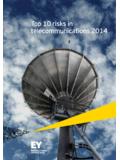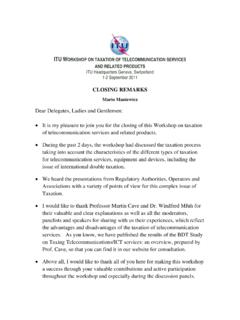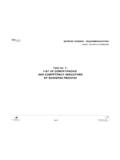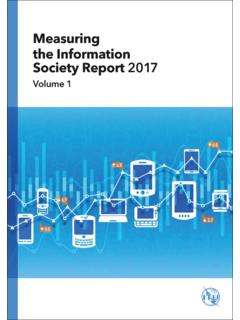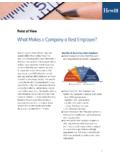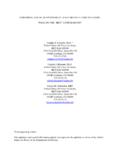Transcription of mHealth
1 Based on the findings of the second global survey on eHealthGlobal Observatory for eHealth series - Volume 3mHealthNew horizons for health through mobile technologies WHO Library Cataloguing-in-Publication DatamHealth: New horizons for health through mobile technologies: second global survey on phone - utilization. , Handheld - utilization. informatics. transfer. collection. global Observatory for eHealth. ISBN 978 92 4 156425 0 (NLM classification: W ) World Health Organization 2011 All rights reserved. Publications of the World Health Organization are available on the WHO web site ( ) or can be purchased from WHO Press, World Health Organization, 20 Avenue Appia, 1211 Geneva 27, Switzerland (tel.: +41 22 791 3264; fax: +41 22 791 4857; e-mail: Requests for permission to reproduce or translate WHO publications whether for sale or for noncommercial distribution should be addressed to WHO Press through the WHO web site ( ).)
2 The designations employed and the presentation of the material in this publication do not imply the expression of any opinion whatsoever on the part of the World Health Organization concerning the legal status of any country, territory, city or area or of its authorities, or concerning the delimitation of its frontiers or boundaries. Dotted lines on maps represent approximate border lines for which there may not yet be full mention of specific companies or of certain manufacturers products does not imply that they are endorsed or recommended by the World Health Organization in preference to others of a similar nature that are not mentioned. Errors and omissions excepted, the names of proprietary products are distinguished by initial capital reasonable precautions have been taken by the World Health Organization to verify the information contained in this publication.
3 However, the published material is being distributed without warranty of any kind, either expressed or implied. The responsibility for the interpretation and use of the material lies with the reader. In no event shall the World Health Organization be liable for damages arising from its in Switzerland. Based on the findings of the second global survey on eHealthGlobal Observatory for eHealth series - Volume 3mHealthNew horizons for health through mobile technologies2011 AcknowledgmentsThis report would not have been possible without the input of the Observatory s extensive network of eHealth experts and the support of numerous colleagues at the World Health Organization headquarters, regional, and country offices. Sincere thanks are due to over 800 eHealth experts in 114 countries worldwide who assisted with the design, implementation, and completion of the second global thanks to the many authors and reviewers who contributed their expertise to this publication including: Patricia Mechael, Nadi Kaonga, and Hima Batavia from the Center for global Health and Economic Development at the Earth Institute, Columbia University for their significant contributions to this report; Hani Eskandar of the International Telecommunication Union for his detailed advice on security issues in mHealth Deployment; Joan Dzenowagis for serving as a primary reviewer; and Lilia Perez-Chavolla for writing the case studies.
4 We would like to thank the following professionals who contributed to the case studies. In Bangladesh Abul Kalam Azad, Ministry of Health & Family Welfare of Bangladesh; Cambodia Ly Sovann, Ministry of Health of Cambodia; Canada Kim Fraser, First Nations Inuit Health, Saskatchewan; Deborah Kupchanko, First Nations Inuit Health, Saskatchewan; Christine Labaty, Health Canada; Shirley Woods, Northern Inter-Tribal Health Authority; Ghana Samuel Quarshie, Ghana Health Service; Eric Woods, Switchboard; Sodzi Sodzi-Tettey, Ghana Medical Association; and Senegal Adele Waugaman, United Nations for this report was provided by Najeeb Al-Shorbaji, Director of Knowledge Management and Sharing at WHO. The report was reviewed by David Aylward, Chris Bailey, Peter Benjamin, Alison Bloch, Garrett Mehl, Robin Miller, Neil Pakenham-Walsh, Getachew Sahlu, Chaitali Sinha, and Diana are grateful for the financial support and collaboration of our partners: the Rockefeller Foundation, United Nations Foundation, and mHealth acknowledge the important role of our partner organization, the International Telecommunication Union, in the global deployment of thanks to Jillian Reichenbach Ott for the design and layout, and Kai Lashley for editing.
5 The global survey and this report were prepared and managed by the WHO global Observatory for eHealth: Misha Kay, Jonathan Santos, and Marina Takane. iv Photo credits: Front cover - Top, Centre, Bottom: Dreamstime , PAGE vii - Top, Bottom: Dreamstime , PAGE 1 - Left, Centre, Right: Dreamstime , PAGE 4 - Dreamstime , PAGE 5 - Left: WHO/Nadia Bettega - Centre, Right: Dreamstime , PAGE 8 - WHO/Girish Babu Bommankanti, PAGE 9 - Left, Centre, Right: Dreamstime , PAGE 18 - WHO/Nadia Bettega, PAGE 19 - Left: WHO/Jessica Otieno - Centre, Right: Dreamstime , PAGE 29 - WHO/Nadia Bettega, PAGE 30 - Dreamstime , PAGE 32 - Ministry of Health and Family Welfare, Bangladesh, PAGE 36 - Dreamstime , PAGE 37 - Brian Levine, 2009 (Courtesy of Switchboard), PAGE 41 - WHO/Damien Walmsley, PAGE 44 - Dreamstime , PAGE 45 - UN Foundation/Dalberg, PAGE 47 - WHO/Nadia Bettega, PAGE 48 - Dreamstime , PAGE 49 - Jim Holmes, WHO/WPRO Image Bank, PAGE 50 - Ministry of Health, Cambodia, PAGE 51 - Dreamstime , PAGE 55 - WHO/Girish Babu Bommankanti, PAGE 56 - Dreamstime , PAGE 56 - File Hills Qu Appelle Tribal Council, First Nations, Saskatchewan, Canada, PAGE 58 - Touchwood Agency Tribal Council, First Nations, Saskatchewan, Canada, PAGE 63 - Left, Centre, Right: Dreamstime , PAGE 70 WHO/ Alberto Aguayo, PAGE 71 - Left, Centre, Right.
6 Dreamstime , PAGE 74 - Dreamstime , PAGE 75 - Left, Centre, Right: Dreamstime , PAGE 78 - Dreamstime , PAGE 98 - Dreamstime , Back cover - Top, Centre, Bottom: Dreamstime. v Table of contentsAcknowledgments ivAcronyms and abbreviations viiiExecutive summary 11 Overview 51 1 Defining mHealth 61 2 Second global survey on eHealth 61 3 Overview of findings 72 global results 92 1 mHealth initiatives globally 92 2 Categories of mHealth initiatives, globally 122 3 Adoption of mHealth initiatives by WHO region 142 4 Adoption of mHealth initiatives by World Bank income group 163 Results and analysis by mHealth category 193 1 Health call centres/Health care telephone help line 193 2 Emergency toll-free telephone services 223 3 Treatment compliance 233 4 Appointment reminders 253 5 Community mobilization & health promotion 263 6 Raising awareness 273 7 Mobile telemedicine 343 8 Public health emergencies 403 9 Health surveys and surveillance 423 10 Patient monitoring 523 11 Information
7 Initiatives 543 12 Decision support systems 603 13 Patient records 61vi 4 Barriers to mHealth Implementation 634 1 Barriers by WHO region 664 2 Barriers by World Bank income group 685 Evaluation of mHealth initiatives 715 1 Survey results 715 2 Relevant literature 736 Conclusion 757 References 79 Appendix 1 Methodology of the second global survey on eHealth 83 Purpose .. 83 Survey implementation .. 84 Literature review .. 92 References .. 92 Appendix 2 Member States by WHO region and World Bank income group 93 Appendix 3 global mobile phone subscriptions of responding Member Statesa 99viiAcronyms and abbreviations3G Third generation mobile telecommunicationsAIDS Acquired immunodeficiency syndromeDataCol Data CollectoreHealth Electronic healthEHR Electronic health recordEMR Electronic medical record EMRS Emergency medical response systemsH1N1 Influenza A (H1N1)
8 HIV Human immunodeficiency virus ICT Information and communication technologies IMCI Integrated Management of Childhood IllnessITU International Telecommunications Union mHealth Mobile healthMDGs Millennium Development GoalsMMS Multimedia messaging serviceGMA Ghana Medical AssociationGDP Gross domestic productGNI Gross national income GOe global Observatory for eHealthGPRS General packet radio serviceGPS global positioning system OECD Organisation for Economic Co-Operation and DevelopmentPDA Personal digital assistant RFID Radio frequency identification SIM Subscriber identity moduleSMS Short message service SQL Structured Query LanguageTB Tuberculosis UN United NationsWAP Wireless application protocolWHO World Health Organization viiiExecutive summaryThe use of mobile and wireless technologies to support the achievement of health objectives ( mHealth ) has the potential to transform the face of health service delivery across the globe.
9 A powerful combination of factors is driving this change. These include rapid advances in mobile technologies and applications, a rise in new opportunities for the integration of mobile health into existing eHealth services, and the continued growth in coverage of mobile cellular networks. According to the International Telecommunication Union (ITU), there are now over 5 billion wireless subscribers; over 70% of them reside in low- and middle-income countries. The GSM Association reports commercial wireless signals cover over 85% of the world s population, extending far beyond the reach of the electrical grid. For the first time the World Health Organization s (WHO) global Observatory for eHealth (GOe) has sought to determine the status of mHealth in Member States; its 2009 global survey contained a section specifically devoted to mHealth . Completed by 114 Member States, the survey documented for analysis four aspects of mHealth : adoption of initiatives, types of initiatives, status of evaluation, and barriers to implementation.
10 Fourteen categories of mHealth services were surveyed: health call centres, emergency toll-free telephone services, managing emergencies and disasters, mobile telemedicine, appointment reminders, community mobilization and health promotion, treatment compliance, mobile patient records, information access, patient monitoring, health surveys and data collection, surveillance, health awareness raising, and decision support summary1 Executive summaryThe survey shows there is a groundswell of activity. The majority of Member States (83%) reported offering at least one type of mHealth service. However, many countries offered four to six programmes. The four most frequently reported mHealth initiatives were: health call centres (59%), emergency toll-free telephone services (55%), managing emergencies and disasters (54%), and mobile telemedicine (49%). With the exception of health call centres, emergency toll-free telephone services, and managing emergencies and disasters, approximately two thirds of mHealth programmes are in the pilot or informal stage.










